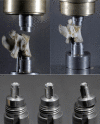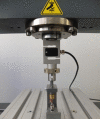Validation of a novel testing machine for the investigation of the biomechanical properties of lumbar vertebrae in an osteoporotic rat model
- PMID: 37004118
- PMCID: PMC10067285
- DOI: 10.1186/s13018-023-03751-3
Validation of a novel testing machine for the investigation of the biomechanical properties of lumbar vertebrae in an osteoporotic rat model
Abstract
Background: For the investigation of the biomechanical properties of bone, various testing devices have been described. However, only a limited number have been developed to test the vertebral body of small animals. The aim of this study was to develop and validate a new bone testing device, which investigates the different biomechanical properties in small-animal vertebrae as a whole, three-dimensional unit, respecting its anatomical structure.
Methods: Thirty-five twelve-week-old female Sprague Dawley rats were utilized. Group 1 was composed of 17 rats with a normal bone metabolism without osteoporosis, while Group 2 consisted of 18 rats with manifest osteoporosis, 8 weeks after ovariectomy. The 5th lumbar vertebra of each animal was tested using the new bone testing device. This device has the ability to be adjusted to the slanted nature of each individual vertebral body and fix the vertebra in a natural position to allow for a non-dislocating axial force application. The device is designed to respect the anatomical three-dimensional shape of the vertebral body, thus avoiding the application of non-anatomic, non-physiological forces and thus preventing a distortion of the biomechanical testing results. The parameters investigated were stiffness, yield load, maximum load and failure load, and the results were compared to current literature values.
Results: The conduction of the biomechanical bone testing of the vertebral bodies with the new device was conductible without any instances of dislocation of the vertebrae or machine malfunctions. Significant differences were found for stiffness, maximum load and failure load between groups, with a lower value in the osteoporotic rats in each parameter tested. The yield load was also lower in the osteoporotic group, however not significantly. The values achieved correlate with those in current literature.
Conclusions: This study demonstrates that the newly developed testing machine is easy to handle and produces valid data sets for testing biomechanical bone parameters of whole vertebral bodies in an established small animal model. Therefore, it can be utilized, also as reference data, to test different structural properties and changes in vertebral bone, for example, in different metabolic settings or under the influence of different pharmaceutical entities in further studies.
Keywords: Axial force application; Biomechanical analysis; Biomechanics; Bone; Compression testing; Lumbar vertebrae; Osteoporosis; Rat vertebrae; Rat vertebral body; Small animal model; Spine; Vertebral body; Vertebral fracture.
© 2023. The Author(s).
Conflict of interest statement
The authors declare that they have no competing interests.
Figures





Similar articles
-
A rat osteoporotic spine model for the evaluation of bioresorbable bone cements.Spine J. 2007 Jul-Aug;7(4):466-74. doi: 10.1016/j.spinee.2006.06.400. Epub 2007 Apr 6. Spine J. 2007. PMID: 17630145
-
Local Treatment of Osteoporotic Sheep Vertebral Body With Calcium Sulfate for Decreasing the Potential Fracture Risk: Microstructural and Biomechanical Evaluations.Clin Spine Surg. 2016 Aug;29(7):E358-64. doi: 10.1097/BSD.0b013e3182a22a96. Clin Spine Surg. 2016. PMID: 25072801
-
An experimental study on the interface strength between titanium mesh cage and vertebra in reference to vertebral bone mineral density.Spine (Phila Pa 1976). 2001 Apr 15;26(8):957-63. doi: 10.1097/00007632-200104150-00022. Spine (Phila Pa 1976). 2001. PMID: 11317121
-
Vertebral body integrity: a review of various anatomical factors involved in the lumbar region.Osteoporos Int. 2007 Jul;18(7):891-903. doi: 10.1007/s00198-007-0373-5. Epub 2007 Apr 3. Osteoporos Int. 2007. PMID: 17404781 Review.
-
Anatomical and biomechanical characteristics of basivertebral foramen and its clinical significance.Zhejiang Da Xue Xue Bao Yi Xue Ban. 2024 Aug 25;53(4):443-449. doi: 10.3724/zdxbyxb-2024-0220. Zhejiang Da Xue Xue Bao Yi Xue Ban. 2024. PMID: 39183068 Free PMC article. Review. Chinese, English.
Cited by
-
Osteoprotective effect of Achyranthes bidentata root extract on osteoporotic rats: a systematic review and meta-analysis.Pharm Biol. 2024 Dec;62(1):691-701. doi: 10.1080/13880209.2024.2407531. Epub 2024 Oct 3. Pharm Biol. 2024. PMID: 39363520 Free PMC article.
References
-
- Baumgart E. Stiffness—an unknown world of mechanical science? Injury. 2000;31(Suppl 2):S14–23. - PubMed
-
- Stuermer EK, Seidlova-Wuttke D, Sehmisch S, Rack T, Wille J, Frosch KH, Wuttke W, Stuermer KM. Standardized bending and breaking test for the normal and osteoporotic metaphyseal tibias of the rat: effect of estradiol, testosterone, and raloxifene. J Bone Miner Res. 2006;21(1):89–96. doi: 10.1359/JBMR.050913. - DOI - PubMed
MeSH terms
LinkOut - more resources
Full Text Sources
Medical

